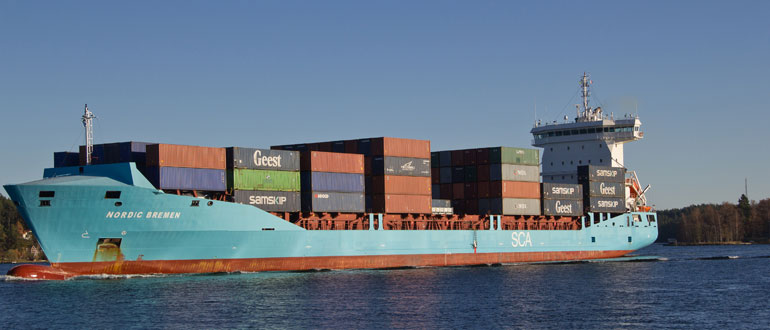
Predicting the lifespan of a ship
As buildings are becoming larger, the risk of unexpected collapse is also growing. Researchers at the University of Southern Denmark have come a step closer to calculating the lifespan of a building.
The world's largest container ship was built in 2015 and is nearly half a kilometre long. In the Saudi Arabian city of Jeddah, the world's largest building is under construction. It will protrude one kilometre into the air.
- Constructions are becoming larger and larger, but at the same time there is focus on restricting the consumption of materials. It means that constructions are becoming softer, and the risk from strong vibrations is increasing, says Esben Orlowitz, PhD at the Centre of Maritime Technology, University of Southern Denmark. He continues:
- Therefore, it is important to consider the construction's sensitivity to vibrations in the design of skyscrapers, bridges, ships or other large constructions.
Sensors reveal vibrations
Esben Orlowitz has written a PhD on how sensors can be used to reveal how sensitive a construction is to vibrations. More particularly, the construction's ability to absorb and limit the vibrations so it can withstand the rigours it is exposed to.
Incorrectly determined attenuation in a construction can lead to unpredicted accidents due to metal fatigue. A fatal example of this is the oil rig Alexander Kielland, which collapsed in 1980 killing 123 people.
But it is also important to avoid vibrations for reasons of comfort. Many people become seasick when they are in tall buildings during a storm, or when the floor vibrates in large halls.
- Everyone wants to reach the point where measurements can be used to predict the lifespan of a construction. For example, it is very important for a shipowner to know whether his ship can sail safely for 5 more years, or whether it should be scrapped. The decision is very dependent on correctly determined attenuation, explains Esben Orlowitz.
Measurement method is reliable
Esben Orlowitz has shown through experiments that the otherwise maligned measurement method OMA is a reliable method in assessing the attenuation of a construction.
- My research has shown that the method can easily be used. OMA also has the advantage that measurements can be taken under actual conditions, for instance while a ship is sailing. Sensors can be set to measure the vibrations on different places on the construction, explains Esben Orlowitz and continues:
- The measurements give a picture of the construction's sensitivity to vibrations, which is important in estimating the lifespan of a construction.
Construction must be completed
But even with the most advanced computer programmes, it is nearly impossible to theoretically calculate the attenuation of large constructions before they are completed.
- The only way to determine how a construction will respond to the stresses it is exposed to is to measure existing constructions. The measurements can then be used to improve similar constructions in the future, explains Esben Orlowitz.
- Constructions are becoming larger and larger, but at the same time there is focus on restricting the consumption of materials. It means that constructions are becoming softer, and the risk from strong vibrations is increasing, says Esben Orlowitz, PhD at the Centre of Maritime Technology, University of Southern Denmark. He continues:
- Therefore, it is important to consider the construction's sensitivity to vibrations in the design of skyscrapers, bridges, ships or other large constructions.
Sensors reveal vibrations
Esben Orlowitz has written a PhD on how sensors can be used to reveal how sensitive a construction is to vibrations. More particularly, the construction's ability to absorb and limit the vibrations so it can withstand the rigours it is exposed to.
Incorrectly determined attenuation in a construction can lead to unpredicted accidents due to metal fatigue. A fatal example of this is the oil rig Alexander Kielland, which collapsed in 1980 killing 123 people.
But it is also important to avoid vibrations for reasons of comfort. Many people become seasick when they are in tall buildings during a storm, or when the floor vibrates in large halls.
- Everyone wants to reach the point where measurements can be used to predict the lifespan of a construction. For example, it is very important for a shipowner to know whether his ship can sail safely for 5 more years, or whether it should be scrapped. The decision is very dependent on correctly determined attenuation, explains Esben Orlowitz.
Measurement method is reliable
Esben Orlowitz has shown through experiments that the otherwise maligned measurement method OMA is a reliable method in assessing the attenuation of a construction.
- My research has shown that the method can easily be used. OMA also has the advantage that measurements can be taken under actual conditions, for instance while a ship is sailing. Sensors can be set to measure the vibrations on different places on the construction, explains Esben Orlowitz and continues:
- The measurements give a picture of the construction's sensitivity to vibrations, which is important in estimating the lifespan of a construction.
Construction must be completed
But even with the most advanced computer programmes, it is nearly impossible to theoretically calculate the attenuation of large constructions before they are completed.
- The only way to determine how a construction will respond to the stresses it is exposed to is to measure existing constructions. The measurements can then be used to improve similar constructions in the future, explains Esben Orlowitz.